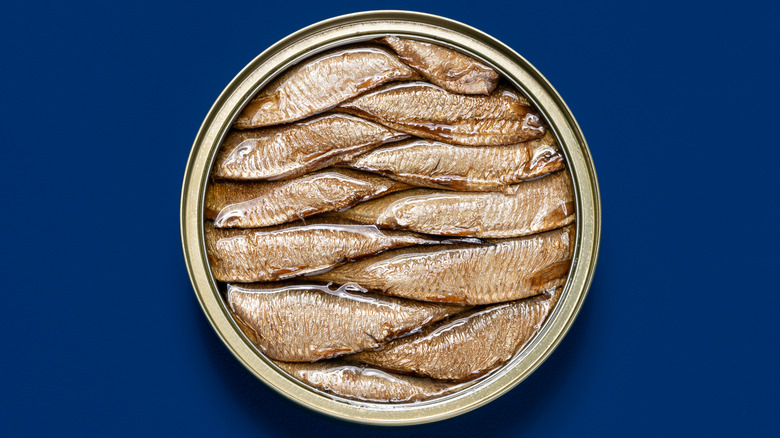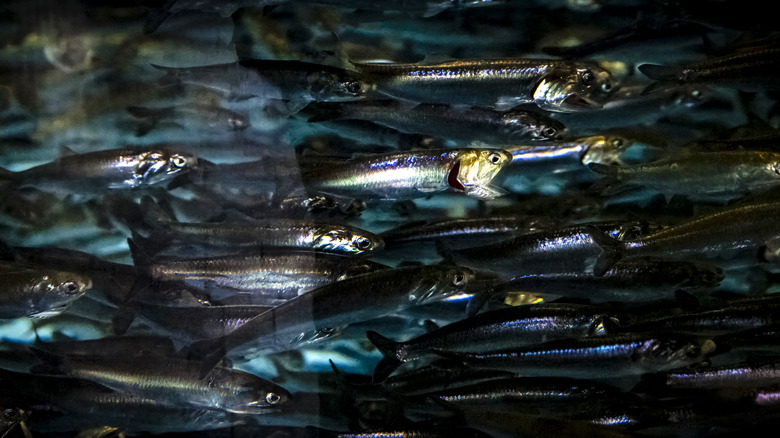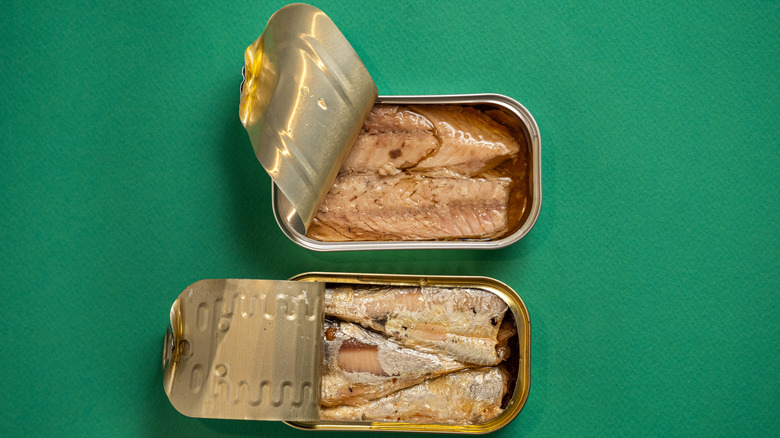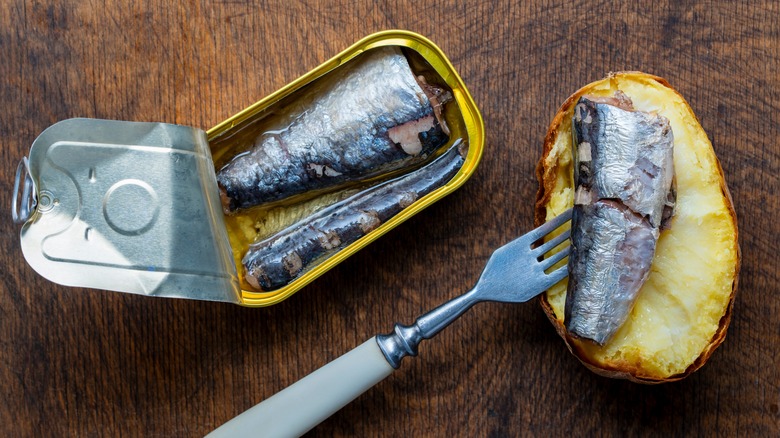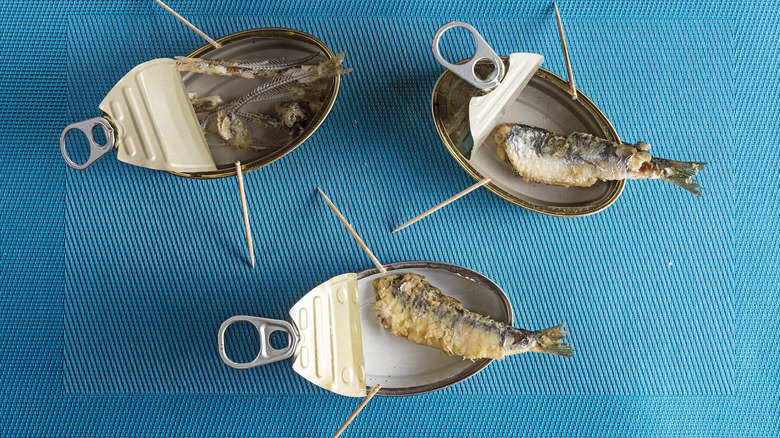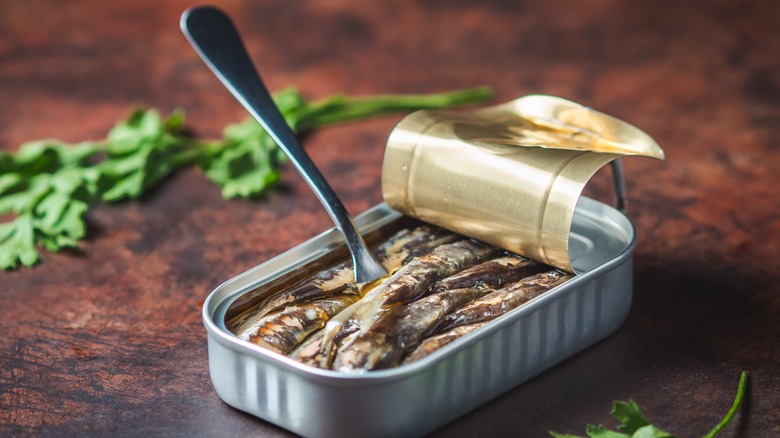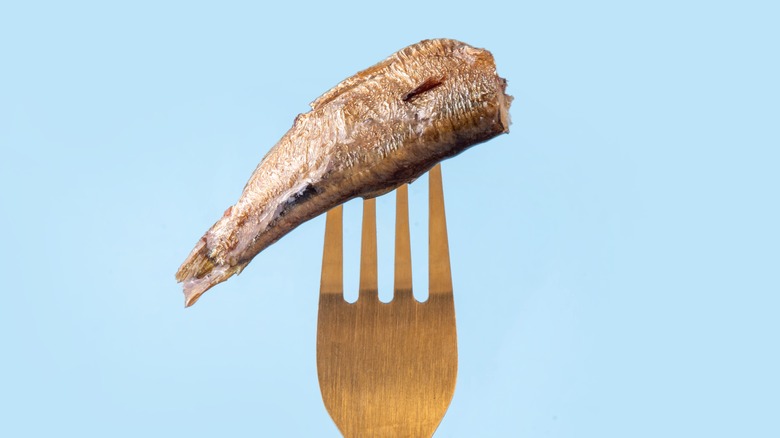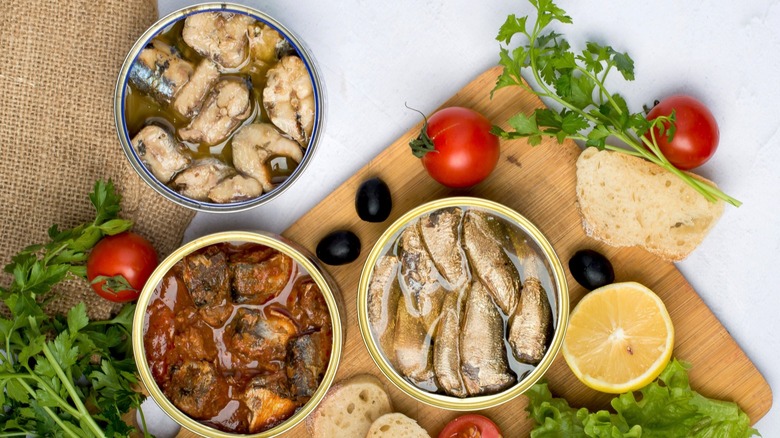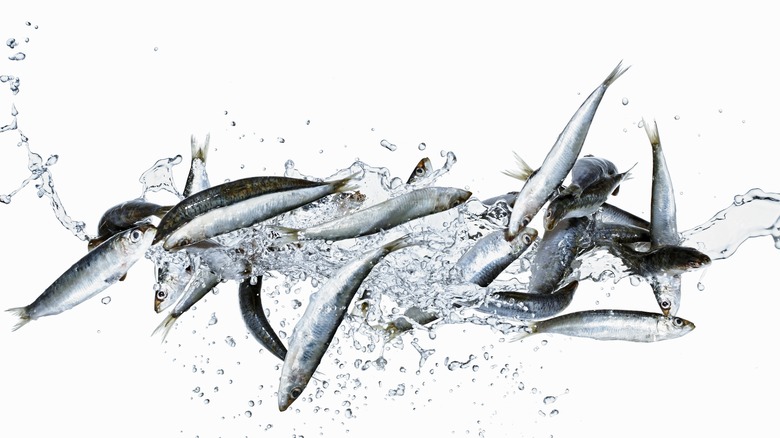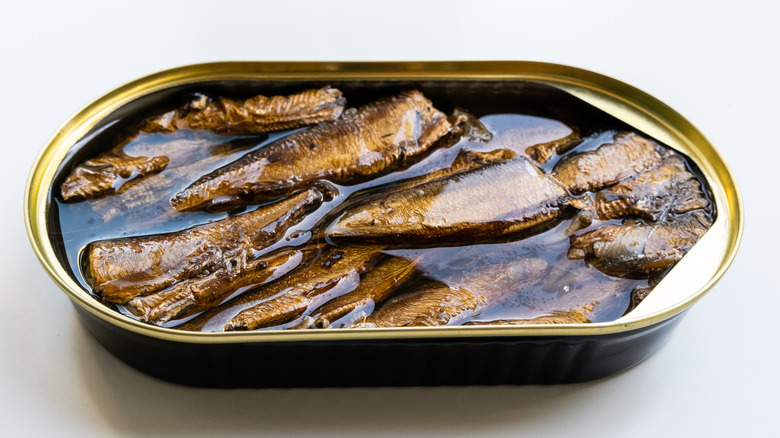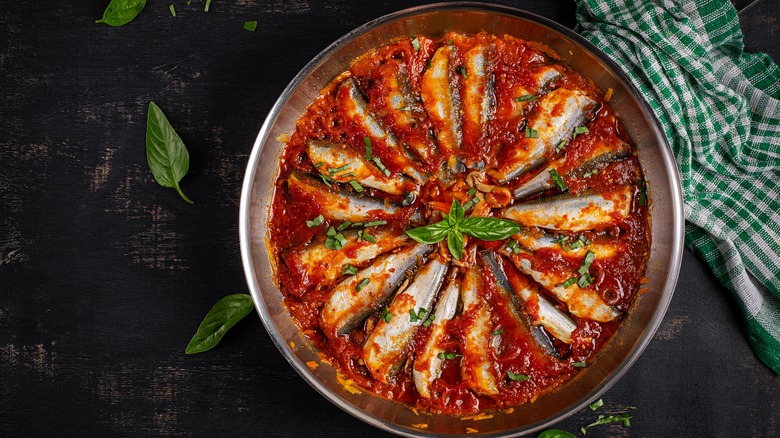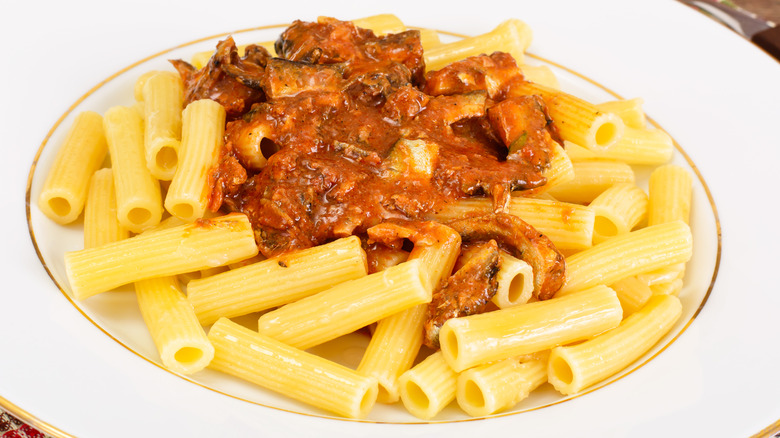11 Mistakes To Avoid When Using Canned Sardines
We may receive a commission on purchases made from links.
The world has Frenchman Nicolas Appert to thank for inventing the food storage system than became the global, multi-billion dollar canned food industry. Apart from extending the shelf lives of innumerable products, the convenience of tinned goods is a major plus, which explains why they are found in almost every household in the United States. They don't gobble up energy like frozen food, and almost anything can be put in a can, including this fast food favorite.
Happily, plenty of more conventional foods also suit tin can packaging, and fish is among the most popular. Canned tuna is among the top most-eaten fish in the United States – pay attention to this issue when buying yours — but it's far from the only one. Salmon, mackerel, and even trout are all available to buy on supermarket or online shelves, and have significant benefits, including vitamins, minerals, and heart-healthy fats.
When it comes to a convenient and flexible form of canned fish, sardines are hard to beat. Whether you nudge them from the tin into a green salad at lunch, or smooth them onto toasted bread for a suppertime snack, they're always delicious. Despite their versatility, consumers don't always get the best out of this tasty fish. To make sure that doesn't happen, here are some mistakes to avoid when using canned sardines.
Choosing a non-sustainable brand of canned sardine
In 2010, scientists revealed how a site in Kenya proved that, almost two million years ago, early humans known as hominins, first ate fish. It has become a key part of our diet in the 21st century — but at a terrible cost. In 2025, the global population stood at more than eight billion and keeping all those people fed has put enormous pressure on natural resources, including fish stocks. Among the challenges facing marine life are climate change, overfishing, habitat destruction, and bycatch — accidentally catching young fish or already endangered species.
Choosing a sustainable brand of sardine (or other canned fish) can help limit the damage being done. According to the Marine Stewardship Council (MSC), there is no such thing as a "sustainable species, only sustainable stocks." Helpfully, it has created a blue fish label for sardines, enabling shoppers to identify tins of fish from stocks that have been certified as sustainable. That means they are not overfished, the sardines are monitored and managed responsibly, and the way they are caught poses minimal environmental harm.
Likewise, Seafood Watch has a traffic light system, with green-rated canned sardines responsibly farmed, caught in an eco-friendly way, and has a minimal environmental impact. Yellow-rated fish are slightly less sustainable, while red-labelled fish should be avoided. It recommends buying sardines caught in Japan or Morocco, but if you don't have time for research, Season sardines are certified wild caught, and Wild Planet is committed to sustainable practices.
Buying canned sardines in water rather than oil
Tinned sardines come in a wide range of packaging, from vintage-looking boxes to funky-colored cans. They can also be bought slathered in tomato, mustard or chili sauces but they are overshadowed by the ongoing battle about whether sardines should be covered in water or oil.
Internet opinions are divided. People banging the drum for sardines in water underscore their milder flavor and flakier texture, making them ideal for newcomers to the fish, while those who prefer oil-packaged fish tout the juicy richness. Online reviews put the latter fractionally ahead of sardines tinned in water, with good reason: The overall flavor is better. That said, the type of oil they come in matters, as well.
Soy and sunflower oil can be acquired tastes, while sardines canned in olive pomace oil, regarded as the poorest quality olive oil, cost less but taste cheap, too. Likewise, fish in refined olive oil is not as healthy as we might think, as the refining process strips out some of the natural antioxidants. Virgin and extra virgin olive oil are the best choices for canned sardines, keeping the fish juicy and soft, while also enhancing the flavor and retaining more of the health benefits.
Leaving the canned sardines open for too long
The internet is awash with videos of people cracking open decades-old cans, often with unimpressive results. But, if we don't make this storage mistake, canned foods really are our BFFs when we're stuck for a quick, tasty meal, or need something to bulk out a recipe. Commercially canned sardines are a great standby, but problems can loom if we don't use them all in one go.
Unopened, canned sardines will last for months but, once opened, the clock starts to tick on their shelf life, and we might not have as long as we'd like. According to Portuguese researchers, how long tinned sardines will stay fresh depends on what sauce they come in. They tested sardines in a light brine, vegetable oil, and tomato sauce, and determined that all three could be safely eaten up to a week after opening, if they are stored in a fridge at 4 F.
Their findings go beyond advice from the USDA, which said that properly stored sardines will keep for up to four days. Unless you're planning to use them within a day or so, leaving unwanted sardines in the can isn't a good idea. Transferring them to a clean plastic or glass container will help them keep their flavor and minimize bacterial growth.
Removing the bones from canned sardines
Eating a fish bone happens more often than many of us might imagine. Researchers in Japan found that bones from popular fish like salmon and mackerel were the most commonly swallowed. Among those that get stuck, most are in people's throats but on rarer occasions, they end up in odder places, such as the sinuses. Nature often takes its course and bone-swallowing incidents end happily, but for home cooks who may be put off eating fish, canned sardines are a delicious — and risk-free — food.
Unlike their fresh counterparts, the bones in tinned sardines have been subjected to sterilization at high temperatures, a process that leaves the bones soft and easily digestible. Lifting out the tiny bones present in canned sardines doesn't just waste time and damage the look of the fish, it can also reduce their nutritional value.
A canned sardine comes complete with skin and bones, as well as that fishy flesh. Think of it as a perfectly packaged dose of multiple vitamins and minerals. The bones themselves are a good source of calcium, boosting the health of our own bones and teeth. Sardine bones also contain selenium, magnesium, and zinc, all of which are great for our immune systems and energy levels. Couple that with the low levels of mercury associated with canned sardines, and it's easy to see why so many home cooks love them.
Eating canned sardines straight from the tin
Some of the best comfort foods come in tins. There are lots of canned pastas worth sticking a fork into, and plenty of canned soups make delicious sauces. Peeling back the lid on a tin of sardines and diving straight in might be a tempting prospect — but eating them straight out of the can isn't necessarily the wisest choice.
Although nutrition experts have said eating a small amount of canned sardines every day isn't bad for us, particularly as they contain less mercury than other canned fish, it's better to stick to the recommended weekly limit of up to three tins of seafood per week. But it's not the only potential issue. For years, canned food was sealed using lead which, as we know now, is not good for human health.
By 1991, can manufacturers in the United States had phased out its use but in other countries, it is still being used. If you think buying American sardines means you can happily eat them straight from the can, there's more bad news. In 2024, tests on several staple foods from U.S. supermarkets, including canned goods, found both bisphenols and phthalates, widely believed to be endocrine disruptors, were present.
Assuming the strong flavor of canned sardines is a bad thing
If there's one thing that has damaged the reputation of canned sardines, it's their "fishy" flavor. Among devotees, it's one of the reasons they love it, but people who are less keen on marine proteins in general can find that robustness off-putting. It's all the more frustrating considering all the health benefits that come with canned sardines.
One solution is to soften the flavor by serving them with fattier ingredients, like mayonnaise, aioli, good quality olive oil or butter. Their richness helps take the edge off tinned sardines' strong flavor, and helps turn them into a sophisticated bite. Another alternative is to add a little of them at a time to a dish, for example mashed potatoes or smoosh a little onto a slice of thickly-cut bread.
Shop around for skinless and boneless canned sardines, like these from Roland, which can help dial down the flavor until you're more accustomed to it. Many people enjoy them with a dollop of mustard to balance the fishy taste, while others swear by lashings of lemon to enhance the flavor of their tinned sardines. If all that fails, switch to tinned mackerel as a milder alternative, before trying their sardine cousins again.
Believing that all canned sardines taste the same
There are lots of different canned sardine brands out there, so it's easy to assume that the fish sitting inside every tin is pretty much the same. Nothing could be further from the truth, as aficionados know all too well. Pacific sardines come from California, as well as Japan and Mexico, and have a softer, flakier texture as well as a nutty flavor. If you want to give them a whirl, Wild Planet's sardines come in extra virgin olive oil and a hint of lemon.
Smaller but no less delicious (and good for us) are European sardines. Regarded as the classic variety of this fish, they're often packed in different, sometimes spicy sauces that complement their balanced flavor, tempting our tastebuds in multiple ways. Home cooks looking for something smokier and more sophisticated should go for Brisling sardines, also known as sprats.
Sardines aren't just popular in Western cuisine, either. South American canned fish are slightly sweeter, come in either brine or soybean oil, and find their way into a wide range of dishes, while in Southern Asian cooking, Indian sardines caught off the shores of Indonesia, Sri Lanka, and India, bring bold flavor to lots of spicy curries and stews.
Rinsing canned sardines before using them
There are some foods that many home cooks believe must be rinsed, either before or after cooking. But, just like washing a raw chicken, or dousing your al-dente pasta, sluicing a freshly opened can of sardines is as big a mistake as asking the internet whether it should be done or not. As well as washing away oodles of flavor, pouring water on them also gets rid of lots of nutrients hidden in the sauce.
That said, rinsing off a thin or unpleasant sauce can make the difference between a miserable plate of tinned sardines and a delicious one and, as this Redditor explained, excess scales can be an issue. Although they said as a rule they never rinsed their canned sardines, this time they ran warm water over their fish "for a second or two" before adding a splash of good olive oil. "The sardines were transformed," they enthused.
Canned sardines that are too oily for some tastes can be scraped a little to minimize the coating. If they're more salty than your usual tins – Portuguese sardines can sometimes be a good example of this — then don't be tempted to rinse them. A better solution is to team your sardines with a blander food, like potatoes or white rice, to balance the meal.
Throwing away canned sardines' oil
Being thrifty in the kitchen isn't just about buying cut-price ingredients or grabbing buy one, get one free bargains. It's also about knowing how to get the most out of everything they use. That can mean everything from using this hack to avoid wasting frozen pizza to giving egg cartons a new lease of life. They would be horrified at the thought of anyone tossing the oil from canned sardines down the sink, especially when it has so many other uses.
First and foremost, it makes for a delicious, infused oil. Don't be put off by the fishy flavor, it works wonderfully for fried onions used in a casserole or stew. If you're a fan of Thai cuisine, canned sardine oil can be a handy alternative to fish sauce. For canned sardines packed in extra virgin olive oil, that's foodie gold and shouldn't be wasted. Some people simply slick it onto a slice of fresh bread and devour it, while others drench a bowl of rice with it.
Other ways to put the oil from canned sardines to good use is to make a dressing from it by adding a little lemon and salt. You can even throw in a few capers for maximum flavor. If you have some chili flakes alongside the dried herbs in your cupboard, mix them into the oil and voilà. The perfect dipping sauce for your next cookout — all from a humble can of sardines.
Overcooking canned sardines
Fish is many people's favorite form of protein but for home cooks, especially those who don't have years of experience under their belts, it can be a tricky ingredient to get right. There are so many common mistakes that can affect all kinds of fresh fish, amateurs can be forgiven for hanging up their aprons altogether. Cooking canned varieties is no less of a challenge, as anyone who has popped a tin of sardines into a hot pan knows.
The thing to remember is these tiny but mighty fish have already been cooked by the time you've cracked open the lid. You're looking to warm the fillets (and their calcium-rich bones), so gently does it when moving them round a skillet. If you're too rough, they'll quickly break up and all you'll end up with is a dry, fishy mush.
Canned salmon is a great addition to vegetable tray bakes but needs a fraction of the cooking time. Add the fillets around 10 minutes before the end of the cooking period and they'll be piping hot and still juicy when served. If you're a lover of canned sardines in tomato sauce, give them a spicy twist by pan-frying shallots, chili, tomato, and garlic in a pan, add the fish with the sauce and cook it all on a medium heat until everything thickens — roughly 10 minutes — before serving with white or brown rice.
Always eating canned sardines in the same way
One of the best things about tinned sardines is their convenience. They're delicious eaten straight out of the can, crumbled into a salad, or served in a warm, tomatoey sauce. One of the biggest mistakes even veteran sardine lovers make is assuming that's all that can be done with them, when the reality is: It's a far more versatile fish than many of us think.
Anyone who has carefully nursed a pan of pinto beans to the peak of perfection (with a hint of a chili kick, naturally), should consider pairing them with a can of quality sardines. It's not just full of creamy, legumey goodness, it's a plate of food that will leave the whole family wanting more. You don't have to go to extreme lengths to find flavor combinations that will excite everyone. Mix your canned sardines with some lemon and chopped parsley and spoon over fried eggs served with buttered toast for the perfect fishermen's eggs.
